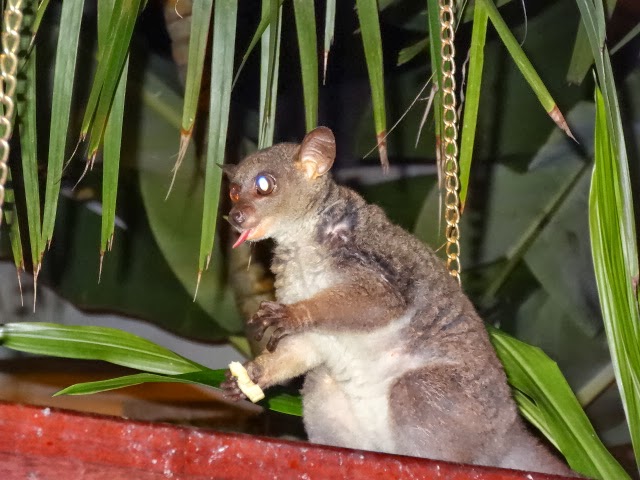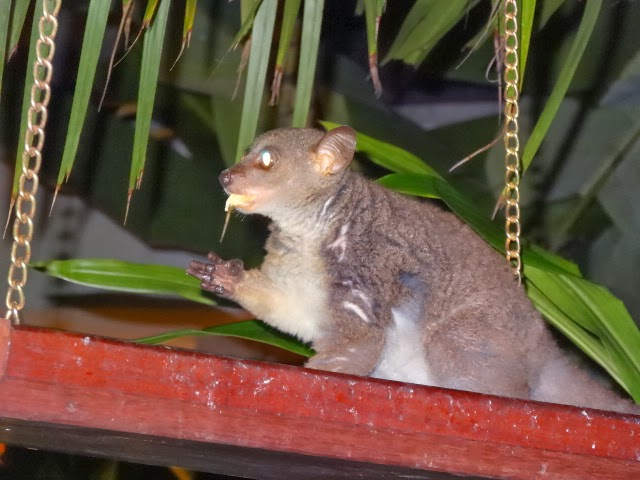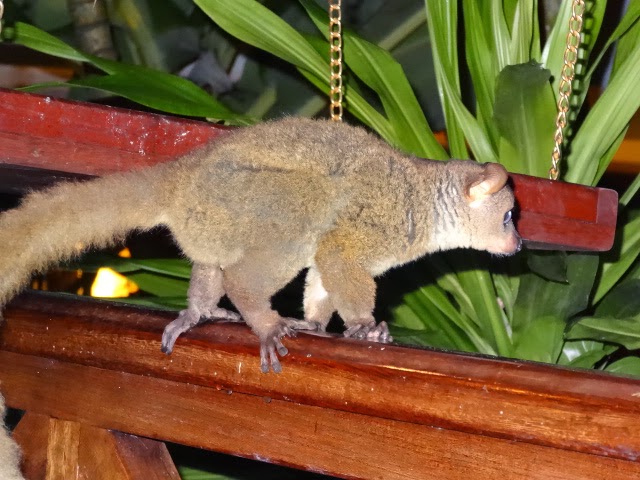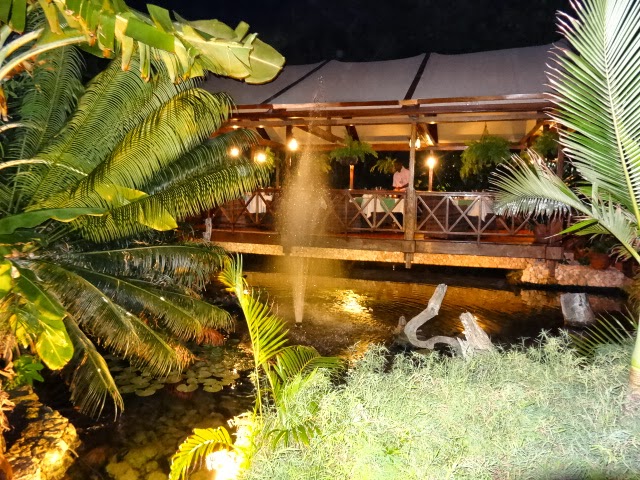 |
| For the first time, last night at Jabula Restaurant, we saw a Thick-Tailed Bushbaby. These are huge compared to the tiny bushbabies, the “Lesser Bushbaby,” which we see each night on the little stand where we place the little cup of fruity yogurt. |
“Sighting of the Day in the Bush”
 |
| From this site: “Thick-tailed Bushbabies have caused alarm for many visitors to the wilderness areas of Africa with their child-like screams during the night with some visitors complaining of child abuse among staff members at lodges. The Afrikaans name for bushbabies is nagapies which mean small night apes.” |
Last night’s dinner at Jabula Lodge and Restaurant couldn’t have been more fun. Sitting at the bar, Tom having his usual brandy and Sprite Zero on the rocks while I had my new favorite low alcohol red wine I’ve been enjoying lately (South Africa’s Four Cousins Skinny Red).
 |
| The environment at Jabula Restaurant is comfortable and inviting. We usually dine outdoors on the veranda, but we had fun with owners Dawn and Leon last night. We ate sitting at the bar for the first time. |
This wine tastes great (now that I’ve acquired a taste for it), and with its low alcohol, low carb content with reduced tannins, it doesn’t cause the potential for aftereffects some of us suffer from when consuming a few glasses of red wine in an evening.
We both perused Jabula‘s expansive menu for quite a while as we sat at the bar, chatting back and forth with Dawn, Leon, and their assistant Lyn. The bar was packed when we arrived, while the locals enthusiastically watched a rugby game on the flat-screen TV, which ended, unfortunately, with South Africa losing to moans and groans in the audience.
 |
| The bar at Jabula Restaurant where Dawn and Leon chat with their guests. It was an enjoyable evening. |
Suddenly, we heard a commotion on the veranda. Guests dining outdoors had spotted a Thick-Tailed Bushbaby on the thatched roof. We’d heard a lot about these huge bushbabies but had yet to see one in our “garden” at night. I couldn’t grab the camera quickly enough and was thrilled to get these photos in the dark of night.
Speaking of “garden,” I will stop using the word “yard” in our posts. Here in Marloth Park and South Africa, they don’t use the word “yard” or “backyard” about their lot included with their home. Also, in South Africa, they don’t call a piece of land a “lot.” It’s called a “stand.”
 |
| Tom ordered Eisbein, a fried pork knuckle that is unbelievably delicious (I always take a few bites of this monstrous item). We brought the bone home for the warthogs. They don’t like the meat, just the bone. Tom splurged and ordered the “chips.” The food and ambiance were exceptional as always. |
Henceforth, when writing our posts and in speaking with others locally, we’ll use the local verbiage as a “garden” instead of a “yard” and of a “stand” instead of a “lot.” We try to fit in.
It’s bad enough that the locals have to speak English when around us when most native Caucasian South Africans speak the Afrikaans language. It amazes us how well they speak English as a second language, even in conjugating verbs and understanding slang and euphemisms.
 |
| But then, he splurged further and ordered a giant plate of fried onion rings. I didn’t complain. He eats healthy meals when I cook and splurges when we dine out. |
As a result, we need to make every effort to blend in, not only in our behavior and interests but also in our acceptance of words they’ve incorporated in their use of the English language.
When we return to the US for a visit in nine and a half months, we can re-do our language to fit into the expectations of conversing in our native language. There are always adjustments such as these when we live in a country for several months.
 |
| My grilled chicken breast, steamed spinach, and carrots. |
And such was the case last night at Jabula. The bar, filled with locals, chatting to other locals in their Afrikaans language, never made us feel “left out” of the conversation. On a dime, any one of them would quickly revert to speaking English for our benefit.
But, this is how it is here in Marloth Park, friendly, open, and easy to make friends with. I should qualify this and state that not all locals in Marloth Park are from South Africa. Many homeowners here in the park are from many other parts of the world, including the UK, Germany, the Netherlands, and other parts of Europe.
 |
| Tom gave me his salad which we ordered without the feta cheese when I no longer eat dairy products. |
The only Americans we’ve met in Marloth are friends Kathy and Don. Kathy grew up in California like me, and Don was born and raised in Kenya. They have homes in other parts of the world, including Hawaii and South Africa, spending part of the year here. Other than the two of them, we’ve yet to meet anyone here from the US.
Today is another perfect weather day, sunny, comfortably warm. After we upload the post, we’ll head out to see what we can find, again, hoping to spot the lioness. It will undoubtedly be a good day.
May you have a good day as well.
Photo from one year ago today, June 24, 2017:
 |
| Last year on this date, Tom and son TJ hung out together at the Minnesota State Fairgrounds, where TJ had his 1954 Buick Special on display next to his canopy set-up at the “Back to the 50’s” annual event. For more photos, please click here. |
























